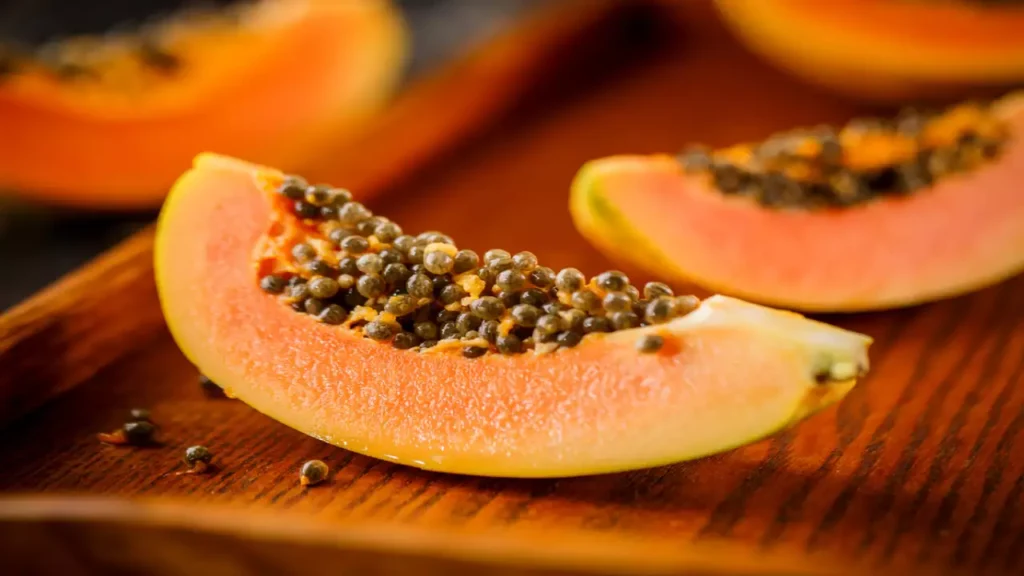Papaya, also known as Carica papaya, is a tropical fruit that has gained popularity worldwide due to its unique taste and numerous health benefits. With its vibrant orange flesh and distinct aroma, papaya offers a delightful sensory experience for fruit enthusiasts. If you’ve never tried this exotic fruit, you may wonder, “What does papaya taste like?” In this article, we will delve into papaya’s intricate flavors and textures, exploring its sweet and tangy notes and its overall culinary versatility.
What Is Papaya?
Papaya is a tropical fruit that belongs to the Caricaceae family. It is native to Central America and South America, but it is now grown in many parts of the world due to its popularity and versatility. The papaya tree is a small, single-trunked tree that can grow up to 15 meters tall, with large, oval-shaped leaves and clusters of yellowish-orange flowers. The fruit of the papaya tree is a pear-shaped berry with a thick, orange skin and a juicy, sweet-tasting pulp. Papayas are rich in vitamins A and C, potassium, and fiber, making them a nutritious and delicious addition to various dishes. They can be eaten raw, used in salads, or cooked in various ways, such as grilled, sautéed, or made into jams and preserves. In addition to their culinary uses, papayas have traditionally been used in herbal medicine for their anti-inflammatory and antioxidant properties.
Where Does Papaya Grow?
Papaya, scientifically known as Carica papaya, is a tropical fruit that grows in various regions worldwide. It is primarily cultivated in countries with warm climates, such as Mexico, Brazil, India, Indonesia, Nigeria, and Thailand. In these regions, papaya trees thrive in well-drained soil and require a minimum temperature of 60°F (15°C) to grow successfully. The fruit is typically found in tropical and subtropical areas due to its sensitivity to frost. Papaya trees can be grown commercially and in home gardens, making it a popular fruit choice for many individuals.
What Does Papaya Taste Like?

Papaya is a tropical fruit known for its unique and distinct flavor. The taste of papaya can be described as a combination of sweet, tangy, and slightly musky. It has a smooth and creamy texture, similar to a ripe melon. The flavor profile of papaya is often compared to a mix of mango, cantaloupe, and citrus fruits. The sweetness varies depending on the ripeness of the fruit, with riper papayas being sweeter and less tangy. The flesh of the papaya is soft and juicy, making it a refreshing and enjoyable fruit. Overall, papaya offers a delightful tropical taste that is refreshing and satisfying.
Explore More Topics For Taste Like
- What Does Acai Taste Like?
- What Does Chai Taste Like?
- What Do Dates Taste Like?
- What Does Cottage Cheese Taste Like?
- What Does Kimchi Taste Like?
- What Does Matcha Taste Like?
- What Does Taro Taste Like?
- What Does Caviar Taste Like?
- What Does Dragon Fruit Taste Like?
- What Does Saffron Taste Like
- What Does Lychee Taste Like
What Part Of A Papaya Can You Eat?
You can eat papaya’s flesh, the most commonly consumed part of the fruit. The flesh is sweet and juicy, with a vibrant orange color. It is rich in vitamins A and C and dietary fiber. The papaya seeds are also edible, although they taste slightly bitter. They can be eaten raw or used in cooking, such as in salads or smoothies. However, it is important to note that the skin and leaves of papaya are not typically consumed due to their bitter taste and potential toxicity.
What To Do With Papaya?
Papaya is a versatile tropical fruit that can be enjoyed in various ways. One popular option is to simply eat it fresh, either on its own or as part of a fruit salad. The sweet and juicy flesh of the papaya makes it a refreshing and healthy snack. Additionally, papaya can be used in smoothies, juices, and shakes, adding a tropical flavor and boosting nutrients. Another way to enjoy papaya is by incorporating it into savory dishes. It can be used in salsas, chutneys, and salads to add a touch of sweetness and a vibrant color.
Furthermore, papaya can be grilled or roasted to enhance its natural flavors. It can also be used in cakes, pies, and ice creams. The possibilities are endless for utilizing papaya in your culinary adventures.
How To Choose A Ripe Papaya?
To choose a ripe papaya:
- Look for one with a vibrant orange or yellow skin color.
- Avoid papayas with green or overly soft skin as they are likely under ripe or overripe, respectively.
- Press the papaya with your fingers – it should yield slightly to pressure but not be too mushy.
A ripe papaya will also have a sweet aroma at the stem end.
How To Store A Papaya?
It is important to follow a few simple steps to store a papaya.
- First, choose a ripe but firm papaya with no bruises or blemishes.
- Leave the papaya at room temperature until it reaches the desired ripeness if it still needs to be ripe.
- Once ripe, you can store the papaya in the refrigerator to prolong its shelf life. However, consuming it within a few days is best to enjoy its optimal flavor and texture.
- Before refrigerating, wrap the papaya in a plastic bag or place it in an airtight container to prevent moisture loss and maintain freshness.
- Avoid storing papayas near ethylene-producing fruits like bananas or apples, as they can speed up the ripening process.
- Lastly, if you have cut open papaya and only want to store a portion of it, cover the exposed flesh tightly with plastic wrap or transfer it to an airtight container before refrigerating.
How To Prepare Papaya?
To prepare papaya:
- Start by washing the fruit thoroughly under running water.
- Cut the papaya in half lengthwise and scoop the seeds with a spoon.
- Peel the skin off each half using a knife or a vegetable peeler.
Once peeled, slice the papaya into desired shapes or cubes. Papaya can be enjoyed as is or added to various dishes such as salads, smoothies, or desserts. It can also be used as a tenderizer for meat due to its natural enzymes. For more detailed instructions and recipe ideas, please visit reputable cooking websites such as Food Network, Allrecipes, or Bon Appétit.
What Are The Health Benefits Of Papaya?
Papaya, scientifically known as Carica papaya, is a tropical fruit that is delicious and offers numerous health benefits. It is rich in essential nutrients, vitamins, minerals, and antioxidants, contributing to overall well-being.
Here, we will delve into the various health benefits of papaya.
Rich in Nutrients
Papaya is a nutrient-dense fruit that provides many essential vitamins and minerals. It is an excellent source of vitamin C, which plays a crucial role in boosting the immune system, promoting collagen production for healthy skin, and acting as an antioxidant to protect cells from damage caused by free radicals. Additionally, papaya contains significant amounts of vitamin A, E, folate, potassium, magnesium, and dietary fiber.
Supports Digestive Health
Papaya contains an enzyme called papain, which aids digestion by breaking down proteins and facilitating their absorption. This enzyme can help alleviate symptoms of indigestion, bloating, and constipation. Moreover, the high fiber content in papaya promotes regular bowel movements and prevents constipation. Regular consumption of papaya can contribute to a healthy digestive system.
Boosts Immune System
As mentioned earlier, papaya is an excellent source of vitamin C. This vitamin plays a vital role in enhancing the immune system’s function by stimulating the production of white blood cells that defend the body against infections and diseases. Consuming papaya regularly can help strengthen the immune system and reduce the risk of common illnesses such as colds and flu.
Promotes Heart Health
Papaya contains several compounds that are beneficial for heart health. The high levels of antioxidants like vitamin C and beta-carotene help prevent the oxidation of cholesterol in the arteries, reducing the risk of heart disease. Additionally, papaya is rich in fiber and potassium, which support heart health by maintaining healthy blood pressure levels and reducing the risk of stroke.
Anti-Inflammatory Properties
Chronic inflammation is linked to various health conditions, including heart disease, diabetes, and certain types of cancer. Papaya contains several compounds with anti-inflammatory properties, such as papain and chymopapain. These enzymes help reduce inflammation in the body, promoting overall health and potentially reducing the risk of chronic diseases.
Conclusion
In conclusion, the taste of papaya can be described as a delightful combination of sweet and musky flavors with hints of tropical fruitiness. Its unique flavor profile is often compared to a mix of melon, mango, and citrus, creating a refreshing and exotic experience for the taste buds. The ripe flesh of papaya is soft and buttery, melting in the mouth with a subtle tanginess that adds depth to its overall taste. Whether enjoyed on its own or incorporated into various culinary creations, papaya offers a distinct and exquisite flavor that will surely please those who appreciate tropical fruits.
Frequently Asked Questions (FAQ’s)
Does Papaya Fruit Taste Good?
Yes, papaya fruit is generally considered to taste good, with a sweet and tropical flavor. It has a unique combination of sweetness and tanginess that many people find enjoyable.
Why Does Papaya Taste Fishy?
Papaya can taste fishy due to a compound called methylthiopropionate, which is naturally present in the fruit and can give off a fishy odor. This compound is more prominent in overripe or spoiled papayas.
What Taste Is Similar To Papaya?
A taste similar to papaya can be found in fruits such as mango and cantaloupe. These fruits share a similar sweet and tropical flavor profile to papaya.
How Do You Eat Papaya And Make It Taste Good?
To eat papaya and make it taste good, add a squeeze of lime or lemon juice, sprinkle some salt or chili powder, or mix it with other fruits in a salad or smoothie. Experimenting with different flavor combinations can help enhance the taste of papaya.
What Does A Ripe Papaya Look Like?
A ripe papaya typically has a yellow or orange skin color, with some green patches, and it should yield slightly to gentle pressure when squeezed. The flesh should be soft and juicy, with a sweet aroma.
How To Get Rid Of Papaya Smell?
To eliminate the papaya smell, try washing your hands with soap and water, using lemon juice or vinegar to neutralize the odor, or using baking soda to absorb the smell.






